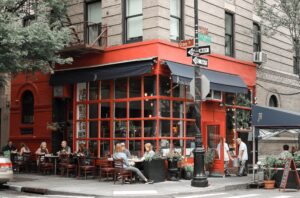How to pick a New York City neighborhood
Eleven things to consider before choosing your new home

Photo by Ana Lanza on Unsplash
I’ve lived in New York City for nearly 20 years, and in that time, I’ve called nine different neighborhoods home. Some have felt more like “home” than others: Boerum Hill, where I lived for three years, was my favorite, with everything I needed—a decent grocery store, some mom-and-pop businesses, access to Brooklyn Bridge Park, and two of my favorite bars—all within a 20-minute walk from my apartment. But ultimately, I decided that I wanted more space for less money, which is how I ended up in my current neighborhood, Bed-Stuy.
These are the calculations that many New Yorkers end up making when choosing where to live: Do I want space, or do I want to be surrounded by people? How important is it to be close to a park? Can I really live off of just one subway line? And how much is all of this going to cost? (In a city where many households are rent-burdened, or paying more than a third of their annual income to rent, price is often the only factor renters consider when picking a place to live.)
For New York newcomers, this may sound overwhelming, and even if you have the means to afford to live wherever you want, there will be trade-offs. Here are 11 things to consider when picking a neighborhood in the city.
1. First, know NYC’s boroughs.
Before you can pick a neighborhood to live in, you’ll need to pick a borough. New York City has five: the Bronx, Brooklyn, Manhattan, Queens, and Staten Island. (NYC & Company, the city’s tourism agency, offers guides to each borough—it’s a great resource for newbies.)
Where you actually land will depend on a few different factors, but each borough has its pros and cons. Manhattan, for example, is the heart of the city, home to several business districts (like Midtown and the Financial District), and what out-of-towners typically think of when they imagine New York. It’s also the most densely populated of all the boroughs, with 1.6 million people crammed into just 22 square miles.
Staten Island, on the other hand, is sleepier—it has fewer than 500,000 full-time residents—and more suburban, with plenty of single-family homes spread out across its nearly 59 square miles. It’s known as the borough of parks, with more than 10,000 acres of green space; it’s also the only borough that’s not connected to the other four by subway, so you’d need to be okay with commuting by ferry or express bus.
The best way to get to know these areas is, of course, by pounding the pavement, but you can also read local publications (SI Live, the Brooklyn Paper, Queens Daily Eagle, etc.) to get a feel for each place.
2. Then, know NYC’s neighborhoods.
Once you’ve identified a borough that feels right for you, it’s time to brush up on its neighborhoods. There are hundreds throughout the city, each one with its own distinct flavor and quirks. Figuring out the best fit for you will involve a lot of research (the internet is your friend!), so budget enough time before you plan to move to look into them thoroughly. (Curbed’s own People’s Guide and renter’s guides are good places to start.)
You might also seek out neighborhoods that serve your specific needs. There are several naturally occurring retirement communities on the Upper West Side, for example. Chelsea and Hell’s Kitchen are among the best neighborhoods for LGBTQ New Yorkers. And many neighborhoods are home to thriving immigrant communities; Washington Heights has a large Dominican population, Astoria has its “Little Egypt,” and so on.
:no_upscale()/cdn.vox-cdn.com/uploads/chorus_asset/file/13720807/Jackson_Heights_MaxTouhey_190125_14_08_29_5DR27547.jpg)
3. But don’t get bogged down in the cachet of certain neighborhoods.
Sex and the City infamously led bright-eyed Carrie Bradshaw wannabes to the West Village in droves in the early aughts. Girls was allegedly responsible for a similar influx of would-be Hannah Horvaths in Greenpoint a decade later. And there are countless others who’ve moved to the Lower East Side or Williamsburg because those areas have been hyped as the coolest parts of the city (once upon a time, anyway).
But just because a neighborhood is supposed to be hip or was made famous by a TV show doesn’t mean it’s the right place for you. Instead, consider your specific wants and needs before settling on a place. (The West Village may be charming, but you’ll pay dearly for the privilege of living there.)
4. Figure out what matters most to you: location, space, or price.
Three of the biggest factors people take into account when picking a place to live are the location, the size, and the price. In New York City, finding an apartment that satisfies all three of those factors is like hitting the lottery—extraordinarily rare, and likely to have you wondering how you got so lucky.
Before you start your search, think long and hard about which of those three factors you’re most wedded to. If space and price are your biggest concerns, you may end up living in a neighborhood that’s a bit off the beaten path; if you’re invested in a location with lots of amenities and things to do, you’ll almost certainly end up paying more in rent.
Once you’ve figured that out, it’s time to do some research. If saving money is your biggest concern, brokerage MNS tracks rental prices in the Bronx, Brooklyn, Queens, and Manhattan, so you can see where the bargains are. It’s harder to get a sense of average square footage by neighborhood; listing sites like StreetEasy, however, let you search for apartments by size, so you can keep tabs on places that aren’t tiny studios. For many people, location—whether it’s close to work, your friends, or your yoga studio—will be the most important factor.
But it’s also important to remember that lives, and priorities, change; you might get a new job, or decide to have a kid, or want to be closer to a subway hub. You might even end up wanting to move to a different neighborhood within a few months of landing your first apartment, and that’s okay! The beauty of living in New York City is that you’ll almost certainly be able to find a place that fits your biggest priorities, whatever those may be at the time.
:no_upscale()/cdn.vox-cdn.com/uploads/chorus_asset/file/13720813/St._George_MaxTouhey_170428_15_22_54_5DS28524.jpg)
5. Take your public transit options into account.
New York may have the most robust public transportation system in the country, but that doesn’t mean it serves all parts of the city equally. There are entire portions of Queens and Brooklyn that are subway deserts; Staten Island, meanwhile, has just one rail line and bus service that’s often slow and unreliable.
On the flip side, there are neighborhoods—like Downtown Brooklyn or the Financial District—that are major subway hubs, making them excellent options if you want to be close to myriad modes of transit. Citi Bike, which is poised for a major expansion in the next few years, has a large presence in parts of Manhattan, Queens, and Brooklyn.
And don’t plan to own a car in NYC: It’s expensive, adds to the city’s already awful traffic, is bad for the environment, and is generally inconvenient to boot.
6. You probably won’t want to be too far from work.
Prepare to spend a lot of time on the subway: The average one-way commute time in New York City is about 36 minutes. You can use that time to catch up on podcasts or read The Power Broker, but you could also pick a neighborhood that’s close to where you’ll work. Most of the city’s central business districts, where you’re most likely to have an office—Midtown, the Financial District, Downtown Brooklyn, Jamaica, Long Island City—aren’t necessarily neighborhoods where you’ll want (or be able to afford) to live, but they’re also served by plenty of subway and bus lines.
This is where the MTA’s app (or even Google Maps) comes in handy: If you know you’ll be working in Midtown and don’t want a long commute, you can look for neighborhoods on subway lines that are close to that particular part of town. On the flip side, if you want to live in, say, Sunnyside, you can use those apps to figure out how long a potential commute to other parts of the city will take, given your transit options. (And be sure to add at least 15 minutes to take subway delays into account.)
:no_upscale()/cdn.vox-cdn.com/uploads/chorus_asset/file/13720808/Financial_District_MaxTouhey_180509_19_22_50_5DR26889.jpg)
7. Do you need peace and quiet?
The city that never sleeps does have some pockets of serenity: According to Renthop, the quietest neighborhoods in the city include the Upper East Side, Borough Park, Bayside, and Brooklyn Heights. You can see the number of noise complaints an area has received through the NYC Open Data portal, but don’t just take those into account when looking for a space that’s relatively quiet. You won’t want to live adjacent to major roadways like the Brooklyn-Queens Expressway (known locally as the BQE), or in areas where major construction projects are happening. (Just ask the Upper East Side residents who lived along Second Avenue while its new subway stops were under construction.)
8. How important is being close to nature?
New York may have a reputation as a concrete jungle, but there are plenty of areas where green space is abundant—and we’re not just talking about Central Park, which is surrounded by some of the city’s most expensive real estate. The largest is Pelham Bay Park, located in the Bronx, home to beaches, horse stables, and a wildlife sanctuary. It’s also close to affordable neighborhoods like Pelham Bay and Morris Park. Inwood Hill Park at the northern tip of Manhattan is enormous, and close to the vibrant neighborhoods of Inwood and Washington Heights.
If you’re more of an outdoorsy type, there are also places for you: Van Cortlandt Park in the Bronx has five hiking trails that offer varying levels of difficulty; in Prospect Park, there are large chunks of old-growth forest. And if you’d like your parks with stellar waterfront views, there are sections of Brooklyn, Queens, and Manhattan (including Roosevelt Island, another affordable enclave) that’ll deliver.
The NYC Parks Department’s website has tons of information about the city’s myriad green spaces, both the “featured parks” (big, famous ones like Central, Prospect, etc.) and the smaller neighborhood oases throughout the five boroughs.
:no_upscale()/cdn.vox-cdn.com/uploads/chorus_asset/file/13720810/Upper_East_Side_MaxTouhey_180509_19_57_20_5DR27255.jpg)
9. You will walk a lot, so prepare accordingly.
It doesn’t matter where you live in New York—you’re going to be spending a lot of time on your feet. And while it’s hard to find a neighborhood in New York City that isn’t pedestrian-friendly, some parts of the city are better in terms of walkability—with parks, grocery stores, bodegas, and other amenities all close by—than others. Let WalkScore be your guide: In Manhattan, you’ll find plenty of shops, restaurants, and bars clustered in neighborhoods like Nolita, the East Village, and the area around Union Square; in Brooklyn, Boerum Hill, Brooklyn Heights, Prospect Heights, and Fort Greene are among the most walkable areas. Bronx neighborhoods like Concourse and East Tremont also score highly, and may be more affordable than other boroughs to boot.
10. Spend some time in the neighborhoods you’re interested in before you commit.
Let’s say you’ve done your research, and you’ve found an apartment in a neighborhood that has everything you want: It’s close to a subway stop, there are a few grocery stores, a park is nearby, and you can afford the rent. You only went there once, but it seems perfect; you should definitely sign the lease, right?
Not so fast. Something may seem perfect on paper, but you might start to notice problems over time. Before you settle on a place, plan repeat visits to the neighborhood, and at different times of day—early morning, late at night, on the weekends when people are out and about. (And don’t forget to check how many noise or other quality-of-life complaints it has, which you can do via via 311’s website.) This way, you’ll get a feel for what it’s actually like to live there.
:no_upscale()/cdn.vox-cdn.com/uploads/chorus_asset/file/13720815/Hamilton_Heights_MaxTouhey_110421_09_05_15_DSC_0072.jpg)
11. Once you move in, treat the entire city like your neighborhood—live in it all.
Congratulations! You’ve picked a neighborhood, signed a lease, and moved in; now, it’s time to get out and experience the rest of the city. Just because you put down roots in Ridgewood doesn’t mean you can’t sample all of the dumpling spots in Flushing, or run through Inwood Hill Park on the weekends, or find the perfect coffee shop in Greenpoint, or go clubbing in Bushwick. The beauty of researching neighborhoods so extensively before moving to New York City is that you’ll find a ton of places you want to explore; once you have a home base, spend the rest of your time doing just that. New York is an enormous, vibrant, wonderful city, with more things to do than you can probably hit in a lifetime—but that doesn’t mean you shouldn’t try.

 USA
USA 






 © Jackson Lieblein, LLC 2015.
© Jackson Lieblein, LLC 2015.
